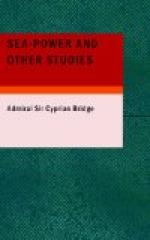[Footnote 87: It would necessitate the use of some technicalities to explain it fully; but it may be said that the bearings of the extremes of the enemy’s line observed from his flag-ship prove that Collingwood was in the station that he ought to have occupied when the British fleet was in the Order of Sailing and close to the wind.]
At a time which, because of the variety in the notations of it, it is difficult to fix exactly, but somewhere between 7 and 8 A.M., the enemy’s ships wore together and endeavoured to form a line to the northward, which, owing to the direction of the wind, must have been about N. by E. and S. by W., or NNE. and SSW. The operation—not merely of wearing, but of both wearing and reforming the line, such as it was—took more than an hour to complete. The wind was light; there was a westerly swell; the ships were under easy sail; consequently there must have been a good deal of leeway, and the hostile or ‘combined’ fleet headed in the direction of Cadiz, towards which, we are expressly told by a high French authority—Chevalier—it advanced.
Nelson had to direct the course of his fleet so that its divisions, when about to make the actual attack, would be just opposite the points to which the respective hostile ships had advanced in the meantime. In a light wind varying in force a direct course to those points could not be settled once for all; but that first chosen was very nearly right, and an alteration of a point, viz. to E. by N., was for a considerable time all that was necessary. Collingwood later made a signal to his division to alter course one point to port, which brought them back to the earlier course, which by the Victory’s compass had been ENE. The eight ships of what has been referred to as the ‘advance squadron’ were distributed between the two main British divisions, six being assigned to Collingwood’s and two to Nelson’s. They did not all join their divisions at the same time, some—probably owing to the distance at which they had been employed from the rest of the fleet and the feebleness of the breeze—not till several hours after the combined fleet had been sighted.
Collingwood preserved in his division a line-of-bearing apparently until the very moment when the individual ships pushed on to make the actual attack. The enemy’s fleet is usually represented as forming a curve. It would probably be more correct to call it a very obtuse re-entering angle. This must have been largely due to Gravina’s ‘squadron of observation’ keeping away in succession, to get into the wake of the rest of the line, which was forming towards the north. About the centre of the combined fleet there was a gap of a mile. Ahead and astern of this the ships were not all in each other’s wake. Many were to leeward of their stations, thus giving the enemy’s formation the appearance of a double line, or rather of a string of groups of ships. It is important to remember




